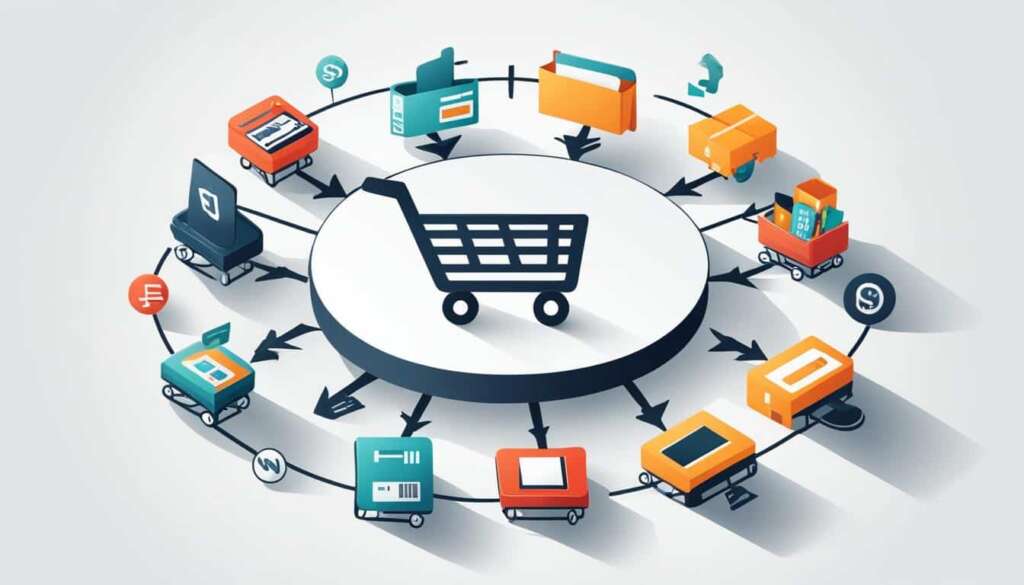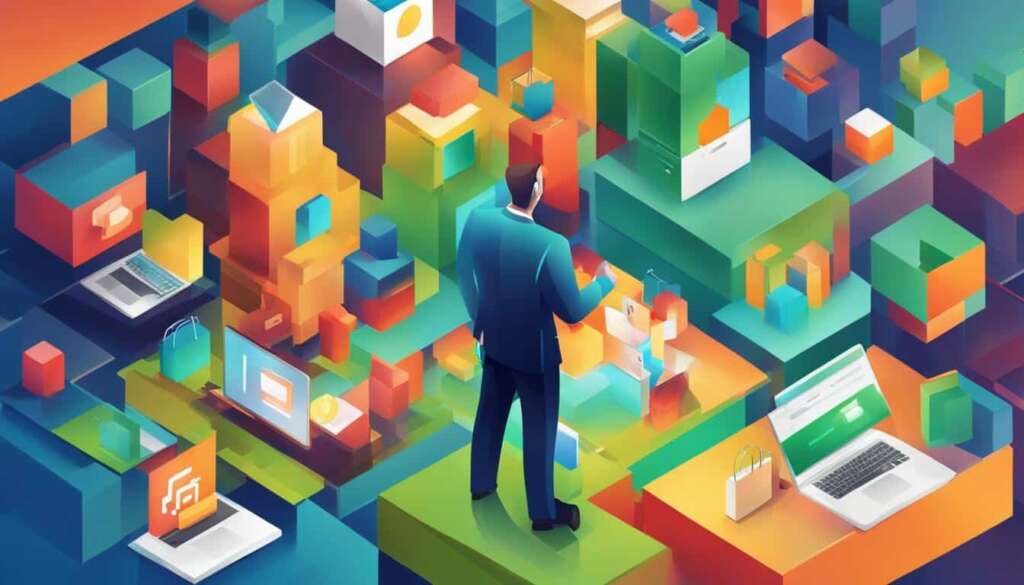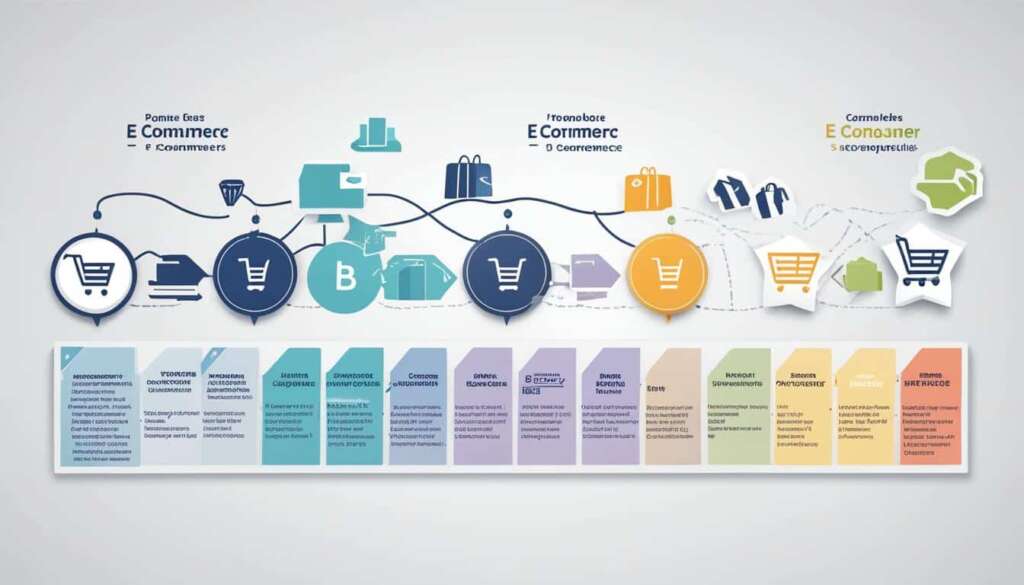Table of Contents
E-commerce, or electronic commerce, refers to the buying and selling of goods and services, as well as the exchanging of funds or data, over the internet. It has become a vital part of the modern retail landscape, with online retail platforms like Amazon and eBay contributing to substantial growth in the industry.
There are four main types of e-commerce transactions: business-to-business (B2B), business-to-consumer (B2C), consumer-to-consumer (C2C), and consumer-to-business (C2B).
E-commerce offers several advantages, such as 24/7 availability, wide product selection, and international reach. However, it also has its disadvantages, including limited customer service and the inability to touch and experience products before purchase.
In this article, we will explore the meaning of e-commerce, delve into the different types of e-commerce, discuss the advantages and disadvantages, and provide insights into how e-commerce works.
How Does E-Commerce Work?
E-commerce operates through the internet, where customers use their devices to access online stores and place orders. As customers make a purchase, their web browser communicates with the server hosting the e-commerce website, relaying data to the order manager. The order manager then forwards the data to various databases, including those that manage inventory and handle payment processing.
After order validation, the order manager notifies the web server and the customer receives a notification of their processed order. The order data is then sent to the warehouse or fulfillment department where products are prepared for shipment or service access.
Fig. 2.1: E-commerce Workflow
| Steps | Description |
|---|---|
| Customer places an order | The customer uses their web browser to access an online store and selects products for purchase. |
| Web browser communication | The customer’s web browser communicates with the server hosting the e-commerce website, relaying order data. |
| Order manager processing | The order manager receives the order data and forwards it to databases for inventory management and payment processing. |
| Order validation | The order manager validates the order, ensuring that the products are available and the payment details are correct. |
| Notification | The order manager notifies the web server of the successfully processed order, triggering a notification to the customer. |
| Warehouse or fulfillment | The order data is sent to the warehouse or fulfillment department, where products are prepared for shipment or service access. |
Types of E-Commerce
E-commerce transactions are classified into different types based on the parties involved. These types include:
- B2B E-commerce: Involves transactions between businesses, such as online directories and exchange websites.
- B2C E-commerce: Refers to businesses selling products or services directly to consumers, with intermediaries handling logistics.
- D2C E-commerce: Allows businesses to sell products directly to consumers without intermediaries.
- C2C E-commerce: Enables consumers to trade products, services, and information with each other through online platforms like auctions and classified ads.
- C2B E-commerce: Involves consumers making their products or services available for businesses to purchase.
- B2A and C2A E-commerce: Involve transactions between businesses or consumers and public administration or government bodies.
- Mobile Commerce (M-commerce): Refers to online sales transactions conducted using mobile devices.
These types of e-commerce cater to different needs and provide a variety of opportunities for businesses and consumers.

Advantages of E-Commerce
E-commerce offers numerous benefits to businesses and consumers alike, revolutionizing the way we shop and conduct business. Let’s explore some of the key advantages:
- Around-the-Clock Availability: With e-commerce, customers can browse and shop at any time, enjoying 24/7 access to online stores. This convenience allows for flexible shopping and caters to customers’ varying schedules.
- Speed of Access: Compared to physical stores, e-commerce provides faster access to products. Quick page loading and user-friendly checkout processes ensure a seamless and efficient shopping experience, saving customers time and effort.
- Wide Selection: Online platforms can stock a vast array of products, providing customers with an extensive selection to choose from. Whether it’s niche products or popular items, e-commerce offers a wide range of choices, meeting diverse customer needs and preferences.
- Easy Accessibility: E-commerce platforms feature user-friendly interfaces and robust search features, making it easy for customers to find the products they’re looking for. Intuitive navigation enhances the overall shopping experience, ensuring customers can locate desired products quickly and efficiently.
- International Reach: One of the most significant advantages of e-commerce is its global nature. Businesses can sell products to customers worldwide, eliminating geographical limitations and expanding reach. This international presence opens up new markets and opportunities for growth.
- Lower Cost: E-commerce eliminates the need for physical stores, reducing costs associated with rent, utilities, and staffing. Businesses can pass on these savings to customers, offering competitive pricing and value for money. Additionally, online promotions and discounts are common, further enhancing affordability.
- Personalization: E-commerce sites leverage customer data to personalize the shopping experience. Through data analysis and algorithms, customers receive tailored recommendations based on their preferences and browsing history. Personalization enhances customer satisfaction and increases the likelihood of repeat purchases.
- Product Recommendations: E-commerce platforms utilize algorithms to suggest related products based on customer preferences and purchase history. These recommendations offer customers additional options and help them discover new products they may be interested in. By facilitating cross-selling and upselling, product recommendations contribute to increased sales and customer engagement.
Overall, e-commerce’s benefits, such as around-the-clock availability, speed of access, wide selection, easy accessibility, international reach, lower costs, personalization, and product recommendations, make it a preferred choice for both businesses and consumers.
Stay ahead of the competition with e-commerce
E-commerce empowers businesses to stay competitive in the digital age, allowing them to reach a wider customer base and provide a seamless shopping experience. By leveraging the advantages of e-commerce, businesses can accelerate growth, increase revenue, and build strong customer relationships.
| Advantage | Description |
|---|---|
| Around-the-Clock Availability | Customers can shop anytime, catering to their varying schedules. |
| Speed of Access | E-commerce offers faster access to products compared to physical stores. |
| Wide Selection | Online platforms provide an extensive range of products. |
| Easy Accessibility | Intuitive navigation and search features make finding products quick and easy. |
| International Reach | Businesses can sell to customers worldwide, expanding their market reach. |
| Lower Cost | E-commerce eliminates the need for physical stores, reducing costs. |
| Personalization | Customer data is used to personalize the shopping experience. |
| Product Recommendations | Algorithms suggest relevant products to customers based on preferences. |
Disadvantages of E-Commerce
While e-commerce offers numerous benefits, it also has its fair share of drawbacks that shoppers and businesses should be aware of. Understanding these disadvantages can help individuals make informed decisions and mitigate potential challenges.
Limited Customer Service: Online stores often lack the personalized assistance and guidance that physical retail locations offer. Customers may have limited access to assistance or face delays in getting their questions answered.
Lack of Product Experience: One of the main drawbacks of e-commerce is the inability to physically touch, feel, or try products before making a purchase. This can lead to uncertainty and hesitancy in buying certain items, especially those requiring sensory experiences like clothing or furniture.
Wait Time: Another drawback of e-commerce is the time it takes for products to be delivered. Unlike instant gratification in physical stores, customers need to wait for the shipping process to complete before receiving their purchases. This can be inconvenient, especially for time-sensitive situations.
Security Issues: Security is a significant concern in e-commerce due to the risks of hacking and fraudulent activities. Hackers can create fake websites or gain unauthorized access to personal and financial information. It is crucial for both customers and businesses to take precautionary measures to ensure secure transactions and protect sensitive data.
To illustrate the disadvantages of e-commerce, consider the following table:
| Disadvantages | Description |
|---|---|
| Limited Customer Service | Online stores may have minimal support or delays in customer assistance |
| Lack of Product Experience | Customers cannot physically interact with products before purchase |
| Wait Time | Customers have to wait for products to be shipped |
| Security Issues | Risks of hacking and fraudulent activities |
These drawbacks emphasize the importance of balancing the convenience and accessibility of e-commerce with these potential challenges. By being aware of the disadvantages and taking necessary precautions, individuals and businesses can navigate the world of e-commerce more effectively.

Conclusion
E-commerce has revolutionized the way we shop and conduct business, leaving a lasting impact on the retail industry. The growth of online marketplaces and the rise of e-commerce platforms like Amazon have transformed the way goods and services are bought and sold. The convenience, accessibility, and wide range of options offered by e-commerce have attracted both consumers and businesses.
Despite its many benefits, it is important to acknowledge the limitations of e-commerce. Limited customer service and the lack of product experience can pose challenges for online shoppers. However, these drawbacks have not deterred the overall success and impact of e-commerce in reshaping the retail landscape.
As e-commerce continues to develop, it opens up new opportunities for businesses to reach a global audience and for consumers to access a vast array of products and services. The growth of online marketplaces exemplifies the transformative power of e-commerce in expanding economic activities and driving innovation.
P
FAQ
What is e-commerce?
E-commerce, or electronic commerce, refers to the buying and selling of goods and services, as well as the exchanging of funds or data, over the internet.
What are the types of e-commerce?
The main types of e-commerce transactions are business-to-business (B2B), business-to-consumer (B2C), consumer-to-consumer (C2C), and consumer-to-business (C2B).
What are the advantages of e-commerce?
E-commerce offers several advantages such as 24/7 availability, wide product selection, and international reach.
What are the disadvantages of e-commerce?
Some disadvantages of e-commerce include limited customer service and the inability to touch and experience products before purchase.
How does e-commerce work?
In an e-commerce transaction, a customer uses their device to access an online store and place an order. The web browser communicates with the server hosting the website, relaying data to the order manager. The order data is then sent to various databases for inventory and payment processing, and the customer receives a notification once their order is processed.
What are the types of e-commerce transactions?
The types of e-commerce transactions involve different parties, including B2B, B2C, C2C, C2B, B2A, C2A, and mobile commerce (m-commerce).
What are the benefits of e-commerce?
E-commerce offers advantages such as around-the-clock availability, quick access, wide product selection, easy searchability, international reach, lower costs, personalization, and product recommendations.
What are the drawbacks of e-commerce?
Some drawbacks include limited customer service, the lack of product experience, wait time for shipping, and security concerns.
How has e-commerce impacted the retail industry?
E-commerce has revolutionized the retail industry, contributing to the growth of online marketplaces and the rise of e-commerce platforms like Amazon.













